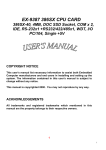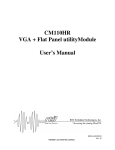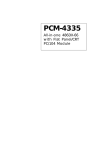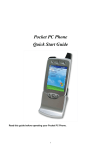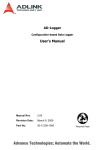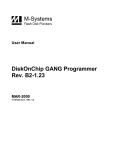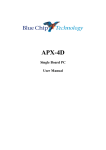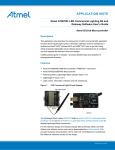Download SBC-357 - Vox Technologies
Transcript
SBC-357 Half-size All-in-one 386SX-40 CPU card FCC STATEMENT THIS DEVICE COMPLIES WITH PART 15 FCC RULES. OPERATION IS SUBJECT TO THE FOLLOWING TWO CONDITIONS: (1) THIS DEVICE MAY NOT CAUSE HARMFUL INTERFERENCE. (2) THIS DEVICE MUST ACCEPT ANY INTERFERENCE RECEIVED INCLUDING INTERFERENCE THAT MAY CAUSE UNDESIRED OPERATION. THIS EQUIPMENT HAS BEEN TESTED AND FOUND TO COMPLY WITH THE LIMITS FOR A CLASS "A" DIGITAL DEVICE, PURSUANT TO PART 15 OF THE FCC RULES. THESE LIMITS ARE DESIGNED TO PROVIDE REASONABLE PROTECTION AGAINTST HARMFUL INTERFERENCE WHEN THE EQUIPMENT IS OPERATED IN A COMMERCIAL ENVIRONMENT. THIS EQUIPMENT GENERATES, USES, AND CAN RADIATE RADIO FREQUENCY ENERGY AND , IF NOT INSTATLLED AND USED IN ACCORDANCE WITH THE INSTRUCTION MANUAL, MAY CAUSE HARMFUL INTERFERENCE TO RADIO COMMUNICATIONS. OPERATION OF THIS EQUIPMENT IN A RESIDENTIAL AREA IS LIKELY TO CAUSE HARMFUL INTERFERENCE IN WHICH CASE THE USER WILL BE REQUIRED TO CORRECT THE INTERFERENCE AT HIS OWN EXPENSE. Copyright Notice This document is copyrighted, 1998, by AAEON Technology Inc. All rights are reserved. AAEON Technology Inc. reserves the right to make improvements to the products described in this manual at any time without notice. No part of this manual may be reproduced, copied, translated, or transmitted in any form or by any means without the prior written permission of AAEON Technology Inc. Information provided in this manual is intended to be accurate and reliable. However, AAEON Technology Inc. assumes no responsibility for its use, nor for any infringements upon the rights of third parties which may result from its use. Acknowledgements ALI is a trademark of Acer Laboratories, Inc. AMD is a trademark of Advanced Micro Devices, Inc. AMI is a trademark of American Megatrends, Inc. AutoCAD and AutoShade are trademarks of Autodesk, Inc. CHIPS Logotype is a registered trademark; Chips 65550 is a trademark of Chip and Technologies, Inc. IBM, PC/AT, PS/2, and VGA are trademarks of International Business Machines Corporation. Lotus, 1-2-3, and Symphony are trademarks of Lotus Development Corp. Microsoft Windows® and MS-DOS are registered trademarks of Microsoft Corp. SMC is a trademark of Standard Microsystems Corporation. TurboDLD Classic is a trademark of Panacea Inc. UMC is a trademark of United Microelectronics Corporation. WordPerfect is a trademark of WordPerfect Corporation. VESA® is a registered trademark of Video Electronics Standards Association. All other product names or trademarks are properties of their respective owners. Part No. 2047357020 SBC-357 3rd Edition Printed in Taiwan June, 2000 Packing list Before you begin installing your card, please make sure that the following materials have been shipped: • 1 supporting CD-ROM • 1 SBC-357 CPU card • 1 Hard disk drive (IDE) interface cable (40 pin) • 1 Floppy disk drive interface cable (34 pin) • 1 6-pin mini-DIN dual outlet adapter for keyboard and PS/2 mouse • 1 parallel port adapter (26-25 pin) and dual outlet adapter kit for COM port (10-9 pin) & (14-9 pin) adapter kit • 2 serial adapter kit (9-10 Pin) • 1 bag of screws and miscellaneous parts If any of these items are missing or damaged, contact your distributor or sales representative immediately. Notice Dear Customer, Thank you for purchasing the SBC-357 board. The user manual is designed to help you to get the most out of the SBC-357, please read it thoroughly before you install and use the board. This product that you have purchased comes with a one-year limited warranty; AAEON will not be responsible for any misuse of the product. Therefore, we strongly urge that user first read the manual before using the product. To receive the lastest version of the user manual, please visit our Web site at: Taiwan: www.aaeon.com.tw U.S.A : www.aaeon.com Contents 1 General Information............................ 1 Introduction ............................................................................ Features ................................................................................... Specifications .......................................................................... Board layout ........................................................................... Card dimensions ..................................................................... 2 2 3 3 5 6 Installation ............................................ 7 Jumpers and connectors ........................................................ 8 Locating jumpers and connectors ......................................... 9 Setting jumpers ..................................................................... 10 Safety precautions ................................................................. 11 Installing DRAM (SIMMs) .................................................. 12 Installing SIMMs .................................................................... 12 Removing SIMMs................................................................... 12 IDE hard drive connector (CN1) ......................................... 13 Floppy drive connector (CN2) ............................................. 15 Connecting the floppy drive .................................................... 15 Parallel (printer) connector (CN3) ...................................... 16 Installing the retaining bracket ................................................. 16 Display connectors (CN10, CN4) ........................................ 17 Reserved IR connector (CN5) .............................................. 19 Power connector (CN6) ........................................................ 19 Serial port connectors (CN7, CN8, CN9, CN11) ................ 20 KB and PS/2 mouse connector (CN12, CN14) ................... 22 Keyboard lock function (CN13) .......................................... 23 IDE LED (JP1) ...................................................................... 24 RS-232/422/485 setting select (JP2) ..................................... 24 Buzzer or external speaker (JP3) ......................................... 25 LCD SHF/ASHF clock select (JP4) ................................. 25 System management Interrupt (JP5) ............................... 26 Hardware Reset (JP6) ........................................................ 26 COM3/COM4 IRQ select (JP7) ...................................... 27 DiskOnChip installation (U15, JP8)................................. 27 LCD driving voltage select (JP9, JP10) ......................... 29 DiskOnChip socket (U15) ................................................. 30 3 AMIBIOS Setup ................................... 31 General information ............................................................ 32 Starting AMIBIOS setup ........................................................ 32 AMIBIOS main menu ............................................................. 32 Using a mouse with AMIBIOS setup ..................................... 33 Using the keyboard with AMIBIOS setup .............................. 33 Standard CMOS setup ....................................................... 34 Advanced CMOS setup ..................................................... 36 Advanced chipset setup ..................................................... 42 Power management setup .................................................. 45 Peripheral Setup .................................................................. 48 Change supervisor password ............................................ 50 Auto configuration with optimal settings ......................... 51 Auto configuration with fail safe settings ........................ 52 Save settings and exit......................................................... 53 Exit without saving ............................................................. 54 4 SVGA Setup......................................... 55 Windows 3.1 ......................................................................... 56 Driver installation - Windows Setup ........................................56 DOS ....................................................................................... 57 SOFTWARE UTILITIES ................................................... 59 The CHIPSCPL utility program .............................................. 59 Installing the utility ................................................................... 59 How to use the utility .............................................................. 59 A Watchdog Timer Demo Program . 61 Watchdog timer Demo Program ....................................... 62 B Installing PC/104 Modules ............... 67 Installing PC/104 modules ................................................. 68 CHAPTER GeneraI Information 1 This chapter provides background information for the SBC-357. Sections include: · Card specifications · Board layout Chapter 1 General Information 1 Introduction The SBC-357 is an all-in-one single board 386 computer with an onboard flat panel/CRT SVGA controller. It packs all the functions of an industrial computer and its display capabilities onto a single, half-size card. This means the SBC-357 is your absolute best solution for embedded applications. The onboard ISA-Bus, flat panel/CRT SVGA controller uses the CHIPS 65545 chipset with up to 1 MB of video memory (512KB onboard). It supports various LCD types including TFT, STN, Normal, and EL. The SBC-357 supports the optional M-Systems DiskOnChip 2000 which is a new generation of high performance single-chip Flash Disk. It provides a Flash Disk (as a BIOS expansion) which doesn't require any bus, slots, or connectors. It is also the optimal solution for Single Board Computers because of its small size, easy integration, plug-and-play functionality, and its low power consumption. The DiskOnChip is available in capacities from 2MB to 72MB and fits in a standard 32-pin DIP socket. The SBC-357 also features three high speed RS-232 serial ports, and one RS-232/422/485 serial port with 16C550 UARTs, one bidirectional SPP/EPP/ECP parallel port, and a floppy drive controller, all onboard. If program execution is halted by a program bug or EMI, the board's watchdog timer can automatically reset the CPU or generate an interrupt. This ensures reliability in unmanned or standalone systems. All configuration is done through software. A single Flash chip holds the system BIOS, VGA BIOS, and the network boot ROM image. This minimizes the number of chips and eases configuration. You can change the display BIOS or install a boot ROM simply by programming the Flash chip. The SBC-357 supports 5 V EDO or FP DRAM. It also provides two 72-pin SIMM (Single In-line Memory Module) sockets for its onboard system DRAM. These sockets give you the flexibility to configure your system up to 32 MB of DRAM using the most economical combination of SIMMs. 2 SBC-357 User Manual Features • 386SX-40 compatible CPU • DiskOnChip (SSD) up to 72MB • Can display both CRT and LCD simultaneously • Connector for PC/104 module expansion • Supports 4 serial ports: Three RS-232 ports and one RS-232/422/485 port Specifications CPU: Embedded in ALI M6117C Chipset Intel 80386SX-40 compatible Data bus: 16-bit BIOS: AMI Flash BIOS (Supports LBA mode HDD) Chipset: ALI M6117C Super I/O Chipset: ITE8663BF & ITE8661F RAM memory: Up to 32MB.Use two 72-pin SIMM socket Shadow RAM memory: Supports system and video BIOS shadow memory IDE hard disk drive interface: Supports up to one IDE (AT bus) hard disk drives. BIOS auto-detect. Floppy disk drive interface: Supports up to two floppy disk drive, 5.25”(360KB and 2MB) and /or 3.5”(720KB, 1.44MB and 2.88MB) Bi-directional parallel port: One Bi-directional printer port (Configurable LPT1, LPT2, LPT3 or disable). Support SPP, ECP and EPP modes. Serial ports: Three RS-232 serial ports and one RS-232/422/485 serial port. Uses 16C550 UARTs with 16 byte FIFO. Supports speeds up to 115Kbps.Ports can be individually configured from COM1 to COM4 or disabled. Real-time clock/calendar: ALI chipset RTC (internal) and quartz oscillator power by a lithium battery. Chapter 1 General Information 3 DMA channel: 7 Interrupt levels: 15 KB/PS2 Mouse connector: 6 pin mini DIN connector supports a standard PC/AT keyboard and mouse. Flat panel VGA interface Chipset: C&T 65545 Display memory: 512KB standard, 1MB option Display type: Supports CRT and flat panel ( TFT , DSTN, mono and EL)display, Can display both CRT and flat panel simultaneously. Resolution: Option up to 1024 x 768 @ 256 colors.(1MB-display memory). Standard 1024 x 768 @ 16 colors (512KB-display memory) SSD interface One 32-pin DIP socket supports M-systems DiskOnChip 2000 series, memory capacity from 2MB to 72 MB. Expansion Slot PC/104 connector: 104-pin connector for a 16 -bit bus expansion. Mechanical and environmental Power supply voltage: +5V (4.75V to 5.25V) Max. power requirements: +5V @ 2A Operating temperature: 32 to 140 °F (0 to 60°C) Board Size: 7.3” (L) X 4.8” (W) (185mm x 122mm) Weight: 0.66 lb. (0.3Kg) 4 SBC-357 User Manual Board layout SBC-357 ITE ITE UM8663F 8661F F65545 B2 BAT DiskOnChip CHIPS ALI M6117C Chapter 1 General Information 5 185.00 73.66 28.80 Card dimensions 19.00 80.645 98.50 121.00 19.60 6 SBC-357 User Manual CHAPTER Installation 2 This chapter describes how to set up the SBC-357 hardware, including instructions on setting jumpers and connecting peripherals, switches, and indicators. Be sure to read all safety precautions before you begin the installation procedure. Chapter 2 Hardware Configuration 7 Jumpers and connectors Connectors on the board link it to external devices such as hard disk drives, a keyboard, or floppy drives. In addition, the board has a number of jumpers that allows you to configure your system to suit your application. The table below lists the function of each of the board jumpers and connectors. Name CN1 Function IDE drive connector CN2 Flopp drive connector CN3 Parallel (printer) connector CN4 LCD connector CN5 IR connector CN6 Power connector CN7 RS-232/422/485 connector (COM2) CN8 COM1 connector CN9 COM3 connector CN10 VGA connector CN11 COM4 connector CN12 Internal keyboard connector CN13 Keyboard lock CN14 KB/PS2 mouse connector JP1 IDE LED JP2 RS-232/422/485 select JP3 Buzzer or external speaker JP4 LCD SHF/ASHF clock select JP5 Green function select (SMI) JP6 Hardware reset JP7 COM3/COM4 IRQ select JP8 DOC address select JP9 LCD driving voltage select JP10 LCD voltage select (VGA CHIPSET) 8 SBC-357 User Manual Locating jumpers and connectors CN8 CN6 CN10 CN14 CN13 CN12 CN3 CN7 CN9 ITE ITE JP2 UM8663F 8661F CN5 JP9 CN2 CN11 JP8 JP7 F65545 B2 DiskOnChip CHIPS CN4 JP4 JP10 BAT ALI M6117C CN1 JP6 JP3 JP1 JP5 Chapter 2 Hardware Configuration 9 Setting jumpers You configure your card to match the needs of your application by setting jumpers. A jumper is the simplest kind of electric switch. It consists of two metal pins and a small metal clip (often protected by a plastic cover) that slides over the pins to connect them. To “close” a jumper you connect the pins with the clip. To “open” a jumper you remove the clip. Sometimes a jumper will have three pins, labeled 1, 2, and 3. In this case you would connect either pins 1 and 2 or 2 and 3. 1 Open Closed 2 3 Closed 2-3 The jumper settings are schematically depicted in this manual as follows: 1 2 3 Open Closed Closed 2-3 A pair of needle-nose pliers may be helpful when working with jumpers. If you have any doubts about the best hardware configuration for your application, contact your local distributor or sales representative before you make any changes. Generally, you simply need a standard cable to make most connections. 10 SBC-357 User Manual Safety precautions Warning! Always completely disconnect the power cord from your chassis whenever you are working on it. Do not make connections while the power is on because sensitive electronic components can be damaged by the sudden rush of power. Only experienced electronics personnel should open the PC chassis. Caution! Always ground yourself to remove any static charge before touching the CPU card. Modern electronic devices are very sensitive to static electric charges. Use a grounding wrist strap at all times. Place all electronic components on a static-dissipative surface or in a static-shielded bag when they are not in the chassis. Chapter 2 Hardware Configuration 11 Installing DRAM (SIMMs) The SBC-357 CPU card provides two 72-pin SIMM (Single Inline Memory Module) sockets and supports up to 32MB. When installing SIMMs, make sure that Bank 1 is filled first. * The SBC-357 CPU card supports single side F.P or EDO DRAM module only. Installing SIMMs Note: that the modules can only fit into a socket one way. 1. Ensure that all power sources disconnected. 2. Slip the memory module into the socket at a moderate angle. 3. Push the module toward the vertical posts at both ends of the socket until the module is upright and the retaining clips at both ends of the module click into place. When positioned correctly, the pins on top of the vertical posts should correspond to the circular holes on the ends of the module. 4. Repeat steps 2 and 3 for each module you install. Removing SIMMs If you need to remove a SIMM, follow the procedures below: 1. Supporting the SIMM with a finger, use a pen or a similarly shaped object and press one retaining clip straight down. 2. Repeat for the other side. When released, the retaining clips will push the SIMM up and out of its upright position. 3. Carefully pull the SIMM out of the socket with your fingers. 4. Repeat the above steps for each module you remove. 12 SBC-357 User Manual IDE hard drive connector (CN1) You can attach two Enhanced Integrated Device Electronics hard disk drives to the SBC-357's internal controller. The card comes with a 40-pin flat piggyback cable. This cable has three identical 40-pin flat-cable connectors. Connecting the hard drive Wire number 1 on the cable is red or blue, and the other wires are gray. 1. Connect one end of the cable to the IDE connector. Make sure that the red (or blue) wire corresponds to pin 1 on the connector, which is labeled on the board (on the right side). 2. Plug the other end of the cable to the Enhanced IDE hard drive, with pin 1 on the cable corresponding to pin 1 on the hard drive. See your hard drive's documentation for the location of the connector. Unlike floppy drives, you can make the connections with any of the connectors on the cable. If you install two drives, you will need to set one as the master and one as the slave. You do this using jumpers on the drives. If you install just one drive, set it as the master. Chapter 2 Hardware Configuration 13 Pin assignments The following table lists the pin numbers and their respective signals: IDE Connector (CN1) Pin 1 Signal Reset Pin 2 Signal GND 3 D7 4 D8 5 D6 6 D9 7 D5 8 D10 9 D4 10 D11 11 D3 12 D12 13 D2 14 D13 15 D1 16 D14 17 D0 18 D15 19 GND 20 N.C. 21 N.C. 22 GND 23 IOW 24 GND 25 IOR 26 GND 27 IORDY 28 BALE 29 N.C. 30 GND 31 IRQ 14 32 -I/O CS16 33 A1 34 N.C. 35 A0 36 A2 37 CS0 38 CS1 39 -ACT 40 GND 14 SBC-357 User Manual Floppy drive connector (CN2) You can attach up to two floppy disks to the SBC-357's onboard controller. You can use any combination of 5 1/4" (360 KB and 1.2 MB) and/or 3 1/2" (720 KB, 1.44 MB, and 2.88 MB) drives. The SBC-357 CPU card comes with a 34-pin daisy-chain drive connector cable. On one end of the cable is a 34-pin flat-cable connector. There are two sets of floppy disk drive connectors, one in the middle, and one on the other end. Each set consists of a 34-pin flat-cable connector (usually used for 3.5" drives) and a printed-circuit board connector (usually used for 5.25" drives). Connecting the floppy drive 1. Plug the 34-pin flat-cable connector into the CN2 connector. 2. Attach the appropriate connector on the other end of the cable to the floppy drive(s). You can use only one connector in the set. The set on the end (after the twist in the cable) connects to the A: drive. The set in the middle connects to the B: drive. Pin assignments The following table lists the pin assignments for the CN2 connector: Floppy drive connector (CN2) Pin 1~33 (odd) Signal GND Pin 2 Signal High density 4, 6 Unused 8 Index 10 Motor enable A 12 Driver select B 14 Driver select A 16 Motor enable B 18 Direction 20 Step pulse 22 Write data 24 Write enable 26 Track 0 28 Write protect 30 Read data 32 Select head 34 Disk change Chapter 2 Hardware Configuration 15 Parallel (printer) connector (CN3) Normally, the parallel port is used to connect the card to a printer. The SBC-357 includes an onboard parallel port, accessed through the CN3 connector, a 26-pin flat-cable connector. The CPU card comes with an adapter cable, which lets you use a traditional DB25 connector. The cable has a 26-pin connector on one end and a DB-25 connector on the other, mounted on a retaining bracket. Installing the retaining bracket The retaining bracket installs at an empty slot in your system's chassis. It provides an external port that gives your parallel peripheral access to the card's parallel port connector. 1. Find an empty slot in your chassis. 2. Unscrew the plate that covers the end of the slot. 3. Screw in the bracket in place of the plate. 4. Next, attach the flat-cable connector to the CN3 connector. Wire 1 of the cable is red or blue, and the other wires are gray. Make sure that Wire 1 connects to Pin 1 of the CN3 connector. Pin 1 is on the right side of the CN3 connector. Pin assignments Parallel (printer) Connector (CN3) Pin 1 Signal Strobe Pin 2 Signal Data 0 3 Data 1 4 Data 2 5 Data 3 6 Data 4 7 Data 5 8 Data 6 9 Data 7 10 -Acknowledge 11 Busy 12 Paper empty 13 +Select 14 -Auto feed 15 -Error 16 -Init printer 17 -Select input 16 SBC-357 User Manual 18~25 GND Display connectors (CN10, CN4) The SBC-357 CPU card's SVGA connector (CN10) supports monochrome displays as well as high resolution color displays. The card also features an LCD connector (CN4), which allows you to connect various flat panel displays. The following table lists their pin assignments: SVGA connector (CN10) Pin 1 Signal Red video 2 Green video 3 Blue video 4 Not used 5 GND 6 Red return (GND) 7 Green return (GND) 8 Blue return (GND) 9 Key (no pin) 10 Sync return (GND) 11 Monitor ID (not used) 12 Monitor ID 13 Horizontal sync 14 Vertical sync 15 Not used Chapter 2 Hardware Configuration 17 LCD connector (CN4) Pin 1 Signal +12 VDC Pin 2 Signal +12 VDC 3 GND 4 GND 5 +5 VDC 6 +5 VDC 7 ENA VEE 8 GND 9 P0 10 P1 11 P2 12 P3 13 P4 14 P5 15 P6 16 P7 17 P8 18 P9 19 P10 20 P11 21 P12 22 P13 23 P14 24 P15 25 P16 26 P17 27 P18 28 P19 29 P20 30 P21 31 P22 32 P23 33 GND 34 GND 35 SHIFT CLK 36 FLM 37 M 38 LATCH CL/C 39 GND 40 ENABKL 41 N.C. 42 N.C. 43 N.C. 44 N.C. 18 SBC-357 User Manual Reserved IR connector (CN5) IR connector (CN5) Pin 5 Function IR_TX 4 GND 3 IR_RX 2 FIR_RX 1 VCC Power connector (CN6) In single board computer (non-passive backplane) applications, you will need to connect the power directly to the SBC-357 board using CN6. This connector is fully compatible with the standard PC power supply connectors. See the following table for its pin assignments: Power port connector (CN6) Pin 1 Signal +5 VDC 2 GND 3 GND 4 +12 VDC Chapter 2 Hardware Configuration 19 Serial port connectors (CN7, CN8, CN9, CN11) The SBC-357 offers three RS-232 serial ports, and one RS-232/422/ 485 serial port. You can select or disable the address for each port with the BIOS Peripheral Setup program. The card mounting bracket holds COM1(CN8), the DB-9 serial port connector for the first port. The COM port connectors on the SBC357 board are CN7 (COM2), CN9 (COM3), CN11 (COM4). The COM2 can be assigned as RS-232 I/F or RS-422/485 I/F. The following sections describe how to make connections. 1 13 (COM2/CN7) 14 CHIPS B69000 2 9 5 BAT Winbond 5582 SIS 6 DiskOnChip 1 (COM1/ CN8, CN9, CN11) 20 SBC-357 User Manual Pi n RS-232 RS-422/485 Pi n RS-232 RS-422/485 1 DCD DCD 2 D SR D SR 3 RX RX 4 RTS RTS 5 TX TX 6 CTS CTS 7 DTR DTR 8 RI RI 9 GND GND 10 NC NC 11 NC 422TXD+ (485TXD+) 12 NC 422TXD(485TXD-) 13 NC 422TXD+ 14 NC 422RXD- Chapter 2 Hardware Configuration 21 KB and PS/2 mouse connectors (CN12, CN14) The SBC-357 board provides two keyboard and one PS/2 mouse connectors. A 5-pin connector (CN9) supports passive backplane applications. A second 6-pin mini-DIN keyboard and PS/2 mouse connector (CN12) on the card mounting bracket supports single board computer applications. Keyboard connector (CN12) Pin 1 Function K.B. clock 2 K.B. data 3 N.C. 4 GND 5 +5 V DC KB & PS/2 mouse connector (CN14) Pin 1 Function K.B. data 2 PS/2 mouse data 3 GND 4 +5 VDC 5 K.B. clock 6 PS/2 mouse clock 22 SBC-357 User Manual Keyboard lock function (CN13) You can use a switch (or a lock) to disable the keyboard. In this state the PC will not respond to any input. This is useful if you don’t want anyone to change or stop a running program. Simply connect the switch between Pins 4 and 5. The pin assignments appear in the following table: keylock (CN13) Pin 1 Function LED Power (+5 V) 2 N.C 3 Ground 4 Keyboard lock 5 Ground Chapter 2 Hardware Configuration 23 IDE LED (JP1) You can connect an LED to indicate that an IDE device is in use. The pin assignments for this jumper are as follows: IDE LED (JP1) Pin 1 Signal -R/W IDE 2 +Vcc RS-232/422/485 setting select (JP2) COM2 can also be assigned as RS-422 or RS-485 I/F. Setting JP2 to assign CN7 (COM2) as RS-422/RS-485 I/F, or otherwise assign CN7 (COM2) as RS-232 I/F. RS-232/422/485 setting select (JP2) RS-232/422/485 setting select (JP2) RS-232* 2 4 6 1 3 5 RS-422 2 4 6 1 3 5 RS-485 2 4 6 1 3 5 * default 24 SBC-357 User Manual Buzzer or external speaker (JP3) The CPU card has its own buzzer. You can disable the internal buzzer and connect an external speaker to EXT SPK. Enabling the external speaker automatically disables the internal buzzer. Buzzer or External Speaker (JP3) Buzzer* External Speaker 1 2 3 4 5 1 2 3 4 5 * default Buzzer or External speaker (JP3) Pin 1 Function Vcc 2 N.C. 3 Buzzer in 4 Speaker output 5 Speaker output LCD SHF/ASHF clock select (JP4) You can select the LCD control signals by setting JP1. The following charts show the available options. LCD SHF/ASHF Clock select (JP4) SHF CLK from C&T65545* 1 2 3 ASHF CLK from SHF CLK 1 2 3 * default Chapter 2 Hardware Configuration 25 System management interrupt (JP5) The user can connect an external switch or jumper cap enabling the SMI (System Management Interrupt), makes the system enter Green function mode. System management interrupt (JP5) * (SMI mode) * default Hardware Reset (JP6) You can connect an external switch to easily reset your computer. This switch restarts your computer as if you turned off the power then turned it back on. The following table shows the pin assignments for JP6. Reset switch (JP6) Pin 1 Function Reset 2 Ground 26 SBC-357 User Manual COM3/COM4 IRQ select (JP7) COM3/COM4 IRQ select (JP7) COM3 → IRQ5 COM4 → IRQ10 COM3 → IRQ10 COM4 → IRQ5 COM3 → IRQ11 COM4 → IRQ5 COM3 → IRQ11 COM4 → IRQ10 COM3 → IRQ5 COM4 → IRQ11 COM3 → IRQ10 COM4 → IRQ11 (default) Chapter 2 Hardware Configuration 27 DiskOnChip Installation (U15, JP8) Please refer to the DiskOnChip manual for detailed information about the DiskOnChip. To install the DiskOnChip on the SBC-357, follow the instructions below. Step 1: Install the DiskOnChip in U15. Step 2: Set SW1 for the memory address of the DiskOnChip memory. SW1 determines the memory adddress of the DiskOnChip memory. If you have another add-on card in the system that uses the same memory, neither the SBC-357 nor the add-on card will function normally. In this case, please change the memory address. DiskOnChip address select (JP8) Disable DC00 D800 D400 D000* CC00 * Default 28 SBC-357 User Manual LCD driving voltage select (JP9, JP10) You can select LCD connector (CN4) driving voltage by setting JP9 & JP10. LCD driving voltage select (JP9, JP10) 5V * 3.3V JP9 JP10 * Default Chapter 2 Hardware Configuration 29 DiskOnChip socket (U15) The DiskOnChip 2000 family of products provides a single chip solid-state flash disk in a standard 32-pin DIP package. The DiskOnChip 2000 is a solid-state disk with no moving parts, resulting in a significant reduction in power consumption and an increase in reliability. The DiskOnChip is a small, plug-and-play Flash disk. It is easy to use and saves integration overhead. The DiskOnChip 2000 family of products is available in capacities ranging from 2MB up to 72MB, unformatted. In order to manage the disk, the DiskOnChip 2000 includes the TrueFFS, MSystems Flash File System proprietary software. The DiskOnChip 2000 package is pin-to-pin compatible with standard 32-pin EPROM devices. OE / Figure 1-MD2200 Pinout pin Name Descr iption Pin N umber Dir ection A0-A12 Addr ess bus 4- 12,23,25-27 Inputs A13-A16 Addr ess bus 2,3,28,29 Inputs D0-D7 Data bus 13- 15,17-21 I/O CE/ C hip Enable 22 Input OE/ Output Enable 24 Input WE/ Wr ite Enable 31 Input NC Not connected 1.30 VCC Pow er 32 GND Ground 16 Note 1: Pins A13 through A16 are not used by the MD2200. They are kept for socket backward compatibility with ED 1100 (DiskOnChip 1000) Note 2: Pins 1 and 30 are not used by MD2200 30 SBC-357 User Manual Note 1 2 CHAPTER AMIBIOS Setup 3 This chapter describes how to set the BIOS configuration data. General information AMIBIOS Setup configures system information that is stored in CMOS RAM. Starting AMIBIOS setup As POST executes, the following appears; Hit <DEL> if you want to run SETUP Press <DEL> to run AMIBIOS setup. AMIBIOS main menu The AMIBIOS setup screen appears as follows: AMIBIOS SETUP — BIOS SETUP UTILITIES (C) 1995 American Megatrends, Inc. All Rights Reserved Standard CMOS Setup Advanced CMOS Setup Advanced Chipset Setup Power Management Setup Peripheral Setup Change User Password Change Supervisor Password Change Language Setting Auto Configuration with Optimal Settings Auto Configuration with Fail Safe Settings Save Settings and Exit Exit Without Saving Standard CMOS setup for changing time, date, hard disk type, etc. ESC: Exit F2/F3: Color F10: Save & Exit ¯- :Sel 32 SBC-357 User Manual Using a mouse with AMIBIOS setup AMIBIOS Setup can be accessed via keyboard, mouse. The mouse click functions are: • single click to change or select both global and current fields • double click to perform an operation in the selected field Using the keyboard with AMIBIOS setup AMIBIOS Setup has a built-in keyboard driver that uses simple keystroke combinations: Keystroke <tab> è, ç, é , ê Function Move to the next window or field. Move to the next field to the right, left, above, or below. <ENTER> Select the current field. + Increments a value. Decrements a value. <ESC> Close the current operation and return to the previous level. <PgUp> Return to the previous page. <PgDn> Advance to the next page. <Home> Return to the beginning of the text. <End> Advance to the end of the text. <ALT>+H Access a help window. <ALT>+<Spacebar> Exit AMIBIOS Setup. Alphabetic keys A to Z are used in the Virtual keyboard, and are not case sensitive. Numeric keys 0 to 9 are in the Virtual keyboard and Numeric keypad. Chapter 3 AMIBIOS Setup 33 Standard CMOS setup The AMIBIOS Setup options described in this section are selected by choosing the Standard CMOS Setup from the AMIBIOS Setup main menu selection screen, as shown below. AMIBIOS SETUP — BIOS SETUP UTILITIES (C) 1995 American Megatrends, Inc. All Rights Reserved Standard CMOS Setup Advanced CMOS Setup Advanced Chipset Setup Power Management Setup Peripheral Setup Change User Password Change Supervisor Password Change Language Setting Auto Configuration with Optimal Settings Auto Configuration with Fail Safe Settings Save Settings and Exit Exit Without Saving Standard CMOS setup for changing time, date, hard disk type, etc. ESC: Exit F2/F3: Color F10: Save & Exit ¯- :Sel Press enter, the Standard CMOS Setup screen appears: AMIBIOS SETUP — STANDARD CMOS SETUP (C) 1995 American Megatrends, Inc. All Rights Reserved Date (mm/dd/yyyy): Wed Sep 10, 1998 Time (hh/mm/ss): 12: 19: 46 Floppy Drive A: 1.44 MB 3½ Floppy Drive B: Not Installed Pri Master Pri Slave : : Type Size AUTO AUTO Boot Sector Virus Protection Month: Day: Year: Jan - Dec 01-31 1901 -2099 34 SBC-357 User Manual Cyln Head WPcom LBA Sec Mode On On Blk Mode On On PIO Mode AUTO AUTO 32Bit Mode Off Off Disabled Esc: Exit ¯- :Sel PgUp/PgDn: Modify F2/F3: Color Date and Time Configuration Select the Date and Time icon in the Standard CMOS setup. The current values for each category are displayed. Enter new values through the keyboard or hit the "+" or "-" key to change values. Floppy A, Floppy B Select the appropriate specifications to configure the type of floppy drive that is attached to the system: 360 KB 5¼", 1.2 MB 5¼", 720 KB 3½", and/or 1.44 MB 3½". The settings have not been pre-installed. Master Disk, Slave Disk Select the appropriate values to configure the hard disk type you are using for the master and the slave. Available types are 1~46, USER, AUTO, Not Installed, and CDROM. The settings have not been preinstalled. Boot Sector Virus Protection Enabling this option allows the system to issue a warning when any program (or virus) issues a disk format command or attempts to write to the boot sector of the hard disk drive. Further confirmation is required before accessing this particular section of the hard disk drive. Chapter 3 AMIBIOS Setup 35 Advanced CMOS setup Select the Advanced CMOS Setup icon from the AMIBIOS Setup main menu to enter Advanced CMOS setup. The "Advanced CMOS Setup" options described in this section are the standard options as shown on the following screen. AMIBIOS SETUP — BIOS SETUP UTILITIES (C) 1995 American Megatrends, Inc. All Rights Reserved Standard CMOS Setup Advanced CMOS Setup Advanced Chipset Setup Power Management Setup Peripheral Setup Change User Password Change Supervisor Password Change Language Setting Auto Configuration with Optimal Settings Auto Configuration with Fail Safe Settings Save Settings and Exit Exit Without Saving Standard CMOS setup for changing time, date, hard disk type, etc. ESC: Exit F2/F3: Color F10: Save & Exit ¯- :Sel Press enter, the Advanced CMOS Setup screen appears: AMIBIOS SETUP — ADVANCED CMOS SETUP (C) 1995 American Megatrends, Inc. All Rights Reserved Quick Boot BootUp Num-Lock BootUp Sequence Floppy Drive Swap Mouse Support System Keyboard Primary Display Display Device LCD Type Password Check OS/2 Compatible Mode Wait For 'F1' if error System BIOS Cacheable Hard disk Delay C000, 32k Shadow C800, 32k Shadow D000, 32k Shadow D800, 32k Shadow E000, 32k Shadow E800, 32k Shadow 36 SBC-357 User Manual Enabled On C:,A: Disabled Enabled Present VGA/EGA Both 640 18BTFT 1 Setup Disabled Enabled Enabled Disabled Enabled Disabled Disabled Disabled Disabled Disabled Available Options: Disabled Enabled ESC: Exit ¯- :Sel PgUp/PgDn: Modify F2/F3: Color Quick Boot Set this option to Enabled to instruct AMIBIOS to boot quickly when the computer is powered on. This option replaces the old "Above 1 MB Memory Test" Advanced Setup option. Setting Description Disabled AMIBIOS tests all system memory. AMIBIOS waits up to 40 seconds for a READY signal from the IDE hard disk drive. AMIBIOS waits for .5 seconds after sending a RESET signal to the IDE drive to allow the IDE drive time to get ready again. AMIBIOS checks for a <Del> key press and runs AMIBIOS Setup if the key has been pressed. Enabled AMIBIOS does not test system memory above 1 MB. AMIBIOS does not wait up to 40 seconds for a READY signal from the IDE hard disk drive. If a READY signal is not received immediately from the IDE drive, AMIBIOS does not configure that drive. AMIBIOS does not wait for .5 seconds after sending a RESET signal to the IDE drive to allow the IDE drive time to get ready again. You cannot run AMIBIOS Setup at system boot, because there is no delay for the Hit <Del> to run Setup message. Boot Up Num Lock Set this option to Off to turn the Num Lock key off when the computer is booted so you can use the arrow keys on both the numeric keypad and the keyboard. The settings are On or Off. The default setting is On. Boot Up Sequence This option sets the sequence of boot drives (floppy drive A:, or hard disk drive C:) that the AMIBIOS attempts to boot from after AMIBIOS POST completes. The settings are C:,A:,CDROM, CDROM,A:,C:, or A:,C:,CDROM. The default setting is A:, C:, CDROM. Chapter 3 AMIBIOS Setup 37 Floppy Drive Swap Set this option to Enabled to permit drives A: or B: to be swapped. The settings are Enabled or Disabled. The default setting is Disabled. Mouse Support When this option is set to Enabled, AMIBIOS supports a PS/2type mouse. The settings are Enabled or Disabled. The default setting is Enabled. System Keyboard This option specifies that a keyboard is attached to the computer. The settings are Present or Absent. The default setting is Present. Primary Display This option specifies the type of display monitor and adapter in the computer. The settings are Mono, CGA40x25, CGA80x25, VGA/EGA, or Absent. The default setting is EGA/VGA. Display Device This option allows user to select the display device. The settings are CRT, LCD, and Both. The default setting is Both. 38 SBC-357 User Manual LCD type This option allows the user to select the LCD type. The SBC357 supports the following LCD types: Brand name Model name Format SBC-357 Sharp 640x480 16bit Color DSTN TFT LM64C08P Y ES Sharp 640x480 8bit Dual-Scan Mono STN LM64P11 Y ES Sharp 640x480 8bit Dual-Scan EL LJ64H052 Y ES Sharp 640x480 18bit Color TFT 1 LQ10D41 Y ES NEC 640x480 12bit Color TFT NL6448AC30-10 Y ES NEC 640x480 18bit Color TFT 2 NL6448AC33-18 Y ES NEC 800x600 18bit Color TFT NL8060AC26-11 Y ES NEC 640x480 4 bit PLASMA PG6404SORM16-3 Y ES Password Check This option enables password checking every time the computer is powered on or every time AMIBIOS Setup is executed. If Always is chosen, a user password prompt appears every time the computer is turned on. If Setup is chosen, the password prompt appears as AMIBIOS is executed. The default is Setup. OS/2 Compatible Mode Set this option to Enabled to permit AMIBIOS to run with IBM OS/2. The settings are Enabled or Disabled. The default setting is Disabled. Chapter 3 AMIBIOS Setup 39 Wait for F1 if Error: AMIBIOS POST error messages are followed by: Press <F1> to continue If this option is set to Disabled, AMIBIOS does not wait for you to press the <F1> key after an error message. The setting is Enabled or Disabled. The default setting is Enabled. System BIOS cacheable When this option is set to Enabled, the contents of the F0000h system memory segment can be read from or written to L2 cache memory. The contents of the F0000h memory segment are always copied from the BIOS ROM to system RAM for faster execution. The settings are Enabled or Disabled. The default setting is Disabled. Hard Disk Delay This option allows you to select the hard disk delay time from 5 sec to 15 sec. The default setting is Disabled. 40 SBC-357 User Manual ROM Location Setting C000, 32K Shadow D000, 32K Shadow E000, 32K Shadow C800, 32K Shadow D800, 32K Shadow E800, 32K Shadow These options control the location of the contents of the 16KB of ROM beginning at the specified memory location. If no adapter ROM is using the named ROM area, this area is made available to the local bus. The settings are: Setting Shadow Description Enabled If an adapter ROM will be using the named ROM area, ROM area are written to the same address in system memory (RAM) for faster execution. Also, the contents of the RAM area can be read from and written to cache memory. The video ROM is not copied to RAM. The contents of the video ROM cannot be read from or written to cache memory. Disabled The contents of C0000h - C3FFFh are written to the same address in system memory (RAM) for faster execution. Chapter 3 AMIBIOS Setup 41 Advanced chipset setup Select the Advanced Chipset Setup from the AMIBIOS Setup main menu to enter the Chipset Setup. The following configurations are based on the manufacturer's default settings. This section allows you to configure the system based on the specific features of the installed chipset. This chipset manages bus speeds and access to system memory resources, such as DRAM and the external cache. It also coordinates communications between the conventional ISA bus and the PCI bus. It must be stated that these items should never need to be altered. The default settings have been chosen, because they provide the best operating conditions for your system. AMIBIOS SETUP — BIOS SETUP UTILITIES (C) 1995 American Megatrends, Inc. All Rights Reserved Standard CMOS Setup Advanced CMOS Setup Advanced Chipset Setup Power Management Setup Peripheral Setup Change User Password Change Supervisor Password Change Language Setting Auto Configuration with Optimal Settings Auto Configuration with Fail Safe Settings Save Settings and Exit Exit Without Saving Standard CMOS setup for changing time, date, hard disk type, etc. ESC: Exit F2/F3: Color F10: Save & Exit ¯- :Sel AMIBIOS SETUP — ADVANCED CHIPSET SETUP (C) 1995 American Megatrends, Inc. All Rights Reserved AT Bus Clock DRAM Refresh Type DRAM Self-Refresh Slow Refresh RAS Precharge time RAS Active Time Insert wait CAS Precharge Time Insert Wait Memory Write Insert Wait Memory Miss Read Insert Wait ISA I/O High Speed ISA Memory High Speed ISA Write cycle end Insert Wait Memory Hole at 15-16M I/O Recovery I/O Recovery Period 16Bit ISA Insert Wait 42 SBC-357 User Manual :14. 318/2 :RAS only :Disable :15 us :2.5T :Enabled :Enabled :Disabled :Disabled :Disabled :Disabled :Enabled :Disabled :Enabled :0.50 us :Enabled Available Options: 14.318/2 PCLK 2/3 PCLK 2/4 PCLK 2/6 PCLK 2/8 PCLK 2/10 PCLK 2/12 ESC: Exit ¯- :Sel PgUp/PgDn: Modify F2/F3: Color Chipset setup options Function At Bus Clock DRAM Refresh Type DRAM Self-Refresh Slow Refresh RAS Precharge Time RAS Active Time Insert Wait CAS Precharge Time Insert Wait Memory Write Insert Wait Memory Miss Read Insert Wait ISA I/O High Speed ISA memory High Speed ISA Write Cycle and Insert Wait option 14.318/2 PCLK 2/3 PCLK 2/4 PCLK 2/5 PCLK 2/6 PCLK 2/8 PCLK 2/10 PCLK 2/12 CAS/RAS RAS only Disabled Enabled 15 µs 60 µs 120 µs 2.5T 1.5T 3.5T Disabled Enabled Disabled Enabled Disabled Enabled Disabled Enabled Disabled Enabled Disabled Enabled Disabled Enabled Chapter 3 AMIBIOS Setup 43 Memory Hole At 15-16M I/O Recovery I/O Recovery Peried 16 Bit ISA Insert Wait 44 SBC-357 User Manual Disabled Enabled Enabled Disabled 0 µs 0.25 µs 0.50 µs 0.75 µs 1.00 µs 1.25 µs 1.50 µs 1.75 µs 2.00 µs 2.25 µs 2.50 µs 2.75 µs 3.00 µs 3.25 µs 3.50 µs Enabled Disabled Power management setup The Power management setup offers options to help reduce power consumption. To see the options in this group, choose the Power management setup icon from the AMIBIOS setup main menu. AMIBIOS SETUP — BIOS SETUP UTILITIES (C) 1995 American Megatrends, Inc. All Rights Reserved Standard CMOS Setup Advanced CMOS Setup Advanced Chipset Setup Power Management Setup Peripheral Setup Change User Password Change Supervisor Password Change Language Setting Auto Configuration with Optimal Settings Auto Configuration with Fail Safe Settings Save Settings and Exit Exit Without Saving Standard CMOS setup for changing time, date, hard disk type, etc. ESC: Exit F2/F3: Color F10: Save & Exit ¯- :Sel AMIBIOS SETUP — ADVANCED CHIPSET SETUP (C) 1995 American Megatrends, Inc. All Rights Reserved Power Management Mode Clock down in Doze Doze Mode Timeout Standby Mode Timeout Suspend Mode Timeout Power Down HDD in Power Down VGA in VGA Power Down Mode Monitor DRQs DRQ 0 Event DRQ 1 Event DRQ 2 Event DRQ 3 Event DRQ 5 Event DRQ 6 Event DRQ 7 Event Monitor FDD Monitor COM Monitor LPT Monitor IRQs :Disabled :Disabled :Disabled :Disabled :Disabled :Disabled :Disabled :Normal :Disabled :Disabled :Disabled :Disabled :Disabled :Disabled :Disabled :Disabled :Disabled :Disabled :Disabled :Disabled Available Options: Disabled SMI :Enabled ¯- :Sel ESC: Exit PgUp/PgDn: Modify F2/F3: Color Chapter 3 AMIBIOS Setup 45 Power management mode Power management lets you set up your computer to save electricity when it is not actively in use by putting the system into progressively greater power saving modes. In the power management scheme there are four system states which proceed in the following sequence: Disabled à SMI There are two selections for Power Management (Mode): Disabled Turns off PM SMI Maximized power saving by activating maximum power saving settings after one minute of system inactivity. With the exception of Disabled, SMI selections have "fixedmode" settings. Therefore, when PM is set to Disabled, some items which are predefined will become unmodifiable. Power down HDD in When enabled and after the selected time of system inactivity, the hard disk drive will be powered down while all other devices will remain active. Doze mode timeout This sets the period of system inactivity after which the system goes into Doze mode, the most limited power saving state. The settings range from 10 seconds to 2 hours and can be set manually when power management is in SMI. The default setting is Disabled. When the system goes into power saving mode, power management will skip to the next mode in the sequence if this is disabled. 46 SBC-357 User Manual Standby mode timeout This sets the period of system inactivity after which the system goes into Standby mode, the intermediate power saving state. The settings range from 10 seconds to 2 hours and can be set manually when power management is in SMI. The default setting is Disabled. When the system goes into power saving mode, power management will skip to the next mode in the sequence if this is disabled. Suspend mode timeout This sets the period of system inactivity after which the system goes into Suspend mode, the maximum power saving state. The settings range from 10 seconds to 2 hours and can be set manually when power management is in SMI. The default setting is Disabled. When the system goes into power saving mode, power management will skip to the next mode in the sequence if this is disabled. Chapter 3 AMIBIOS Setup 47 Peripheral Setup Peripheral Setup options are displayed by choosing the Peripheral Setup icon from the AMIBIOS Setup main menu. All Peripheral Setup options are described in this section: AMIBIOS SETUP — BIOS SETUP UTILITIES (C) 1995 American Megatrends, Inc. All Rights Reserved Standard CMOS Setup Advanced CMOS Setup Advanced Chipset Setup Power Management Setup Peripheral Setup Change User Password Change Supervisor Password Change Language Setting Auto Configuration with Optimal Settings Auto Configuration with Fail Safe Settings Save Settings and Exit Exit Without Saving Standard CMOS setup for changing time, date, hard disk type, etc. ESC: Exit F2/F3: Color F10: Save & Exit ¯- :Sel AMIBIOS SETUP — PERIPHERAL SETUP (C) 1995 American Megatrends, Inc. All Rights Reserved Onboard IDE Onboard FDC Onboard Parallel Port Parallel Port Mode ECP DMA Parallel Port IRQ Onboard Serial Port 1 Onboard Serial Port 1 RQ Onboard Serial Port 2 Onboard Serial Port 2 IRQ Onboard Serial Port 3 Onboard Serial Port 3 IRQ Onboard Serial Port 4 Onboard Serial Port 4 IRQ :Enabled :Enabled :378 :SPP :DMA3 :IRQ7 :3F8 :4 :2F8 :3 :3E8h :IRQ-A :2E8h :IRQ_B Available Options: Disabled Enabled ESC: Exit ¯- :Sel PgUp/PgDn: Modify F2/F3: Color Onboard IDE This option specifies the onboard IDE controller channels that will be used. The settings are Disabled or Enabled. Onboard FDC This option enables the floppy drive controller on the motherboard. The settings are Enabled, or Disabled. 48 SBC-357 User Manual Onboard Parallel Port This option enables the parallel port on the motherboard and specifies the parallel port base I/O port address. The settings are Disabled, 278, 378, and 3BC. The default setting is Enabled. Parallel Port Mode This option specifies the parallel port mode. ECP and EPP are both bidirectional data transfer sechemes that adhere to the IEEE P1284 specification. The settings are: Setting Description Normal The normal parallel port mode is used. This is the default setting. EPP The parallel port can be used with devices that adhere to the Enhanced Parallel Port (EPP) specification. EPP uses the existing parallel port signals to provide asymmetric bidirectional data transfer driven by the host device. The parallel port can be used with devices that adhere to the Extended Capabilities Port (ECP) specification. ECP uses the DMA protocol to achieve transfer rates of approximately 2.5 Mbs. ECP provides symmetric bidirectional communications. ECP ECP DMA This option is setting for the Parallel Port Mode. The settings are DMA, CH (channel) 0, DMA CH 1, DMA CH2, or DMA CH3. Parallel Port IRQ IRQ7 is used for the Parallel Port (LPT 1). The IRQ can be changed to IRQ5. Onboard Serial Port 1/2/3/4 This option enables serial port 1 on the motherboard and specifies the base I/O port address for serial port 1~4. The settings are Disabled, 3F8h, 3E8h, 2E8h, and 2F8h. Chapter 3 AMIBIOS Setup 49 Change supervisor password 1) Select this option from the main menu 2) Enter the Password and Press <Enter> 3) Retype the Password and Press <Enter> If you forget the password, please contact your distributor for another password which you can use to enter the AMIBIOS setup and change your own password. AMIBIOS SETUP — BIOS SETUP UTILITIES (C) 1995 American Megatrends, Inc. All Rights Reserved Standard CMOS Setup Advanced CMOS Setup Advanced Chipset Setup Power Management Setup Peripheral Setup Change User Password Change Supervisor Password Change Language Setting Auto Configuration with Optimal Settings Auto Configuration with Fail Safe Settings Save Settings and Exit Exit Without Saving Standard CMOS setup for changing time, date, hard disk type, etc. ESC: Exit F2/F3: Color F10: Save & Exit ¯- :Sel 50 SBC-357 User Manual Auto configuration with optimal settings You can load the optimal default settings for the AMIBOIS setup options by selecting it from the main menu. The optimal default settings are best case values that should optimize system performance. If CMOS RAM is corrupted, the optimal settings are loaded automatically. AMIBIOS SETUP — BIOS SETUP UTILITIES (C) 1995 American Megatrends, Inc. All Rights Reserved Standard CMOS Setup Advanced CMOS Setup Advanced Chipset Setup Power Management Setup Peripheral Setup Change User Password Change Supervisor Password Change Language Setting Auto Configuration with Optimal Settings Auto Configuration with Fail Safe Settings Save Settings and Exit Exit Without Saving Standard CMOS setup for changing time, date, hard disk type, etc. ESC: Exit F2/F3: Color F10: Save & Exit ¯- :Sel Chapter 3 AMIBIOS Setup 51 Auto configuration with fail safe settings You can load the Fail Safe settings for the AMIBOIS setup options by selecting it from the main menu. The Fail Safe settings provide the most stable settings, though they may not provide optimal performance. Use this option as a diagnostic aid if the system is behaving erratically. AMIBIOS SETUP — BIOS SETUP UTILITIES (C) 1995 American Megatrends, Inc. All Rights Reserved Standard CMOS Setup Advanced CMOS Setup Advanced Chipset Setup Power Management Setup Peripheral Setup Change User Password Change Supervisor Password Change Language Setting Auto Configuration with Optimal Settings Auto Configuration with Fail Safe Settings Save Settings and Exit Exit Without Saving Standard CMOS setup for changing time, date, hard disk type, etc. ESC: Exit F2/F3: Color F10: Save & Exit ¯- :Sel 52 SBC-357 User Manual Save settings and exit If you select this option and press <Enter>, the values entered in the setup utilities will be recorded in the chipset's CMOS memory. The microprocessor will check this every time you turn your system on and compare this to what it finds as it checks the system. This record is required for the system to operate. AMIBIOS SETUP — BIOS SETUP UTILITIES (C) 1995 American Megatrends, Inc. All Rights Reserved Standard CMOS Setup Advanced CMOS Setup Advanced Chipset Setup Power Management Setup Peripheral Setup Change User Password Change Supervisor Password Change Language Setting Auto Configuration with Optimal Settings Auto Configuration with Fail Safe Settings Save Settings and Exit Exit Without Saving Standard CMOS setup for changing time, date, hard disk type, etc. ESC: Exit F2/F3: Color F10: Save & Exit ¯- :Sel Chapter 3 AMIBIOS Setup 53 Exit without saving Selecting this option and pressing <Enter> lets you exit the Setup program, without recording any new values or changing old ones. AMIBIOS SETUP — BIOS SETUP UTILITIES (C) 1995 American Megatrends, Inc. All Rights Reserved Standard CMOS Setup Advanced CMOS Setup Advanced Chipset Setup Power Management Setup Peripheral Setup Change User Password Change Supervisor Password Change Language Setting Auto Configuration with Optimal Settings Auto Configuration with Fail Safe Settings Save Settings and Exit Exit Without Saving Standard CMOS setup for changing time, date, hard disk type, etc. ESC: Exit F2/F3: Color F10: Save & Exit ¯- :Sel 54 SBC-357 User Manual CHAPTER SVGA Setup 4 The SBC-357 features an onboard flat panel/SVGA interface. This chapter provides instructions for installing and operating the software drivers on the included display driver diskette. Windows 3.1 These drivers are designed to work with Microsoft Windows Version 3.1. You may install these drivers either through Windows or in DOS. Driver installation - Windows Setup 1. Install Windows as you normally would for a VGA display. Run Windows to make sure that it is working correctly. 2. Place the Supporting CD-ROM into your CD-ROM drive. In the Windows Program Manager, choose File from the Options Menu. Then from the pull-down menu, choose Run. At the Command Line prompt, type cd-rom drive: \CD ROM\model name\sbc-357\vga driver \Oemsetup.inf. "cd-rom": the drive letter of your CD-ROM drive "model name": the model number of your product Press the <ENTER> key or click OK to begin the installation. At this point the setup program locates the directory where Windows is installed. For proper operation, the drivers must be installed in the Windows subdirectory. 3. Press <ENTER> to complete the installation. Once completed, the Display Driver Control Panel appears on the screen. You can find the ChipCPL under the Control Panel. The icon allows you to select and load the installed drivers. Changing Display Drivers from Windows To change display drivers from Windows, select the Windows Setup icon from the Main window. You will be shown the current setup configuration. Select Change System Settings from the Option menu. Click on the arrow at the end of the Display line. You will be shown a list of display drivers. Click on the driver you want to select. Then click on the OK button. Follow the directions to complete the setup. 56 SBC-357 User Manual Changing Color Schemes After you change display drivers, you may notice that the color scheme used by Windows looks strange. This is because different drivers have different default colors. You can correct this by choosing the same color scheme or a new color scheme. First select the Control Panel from the Main window. Select the Color icon. You will be shown the current color scheme. Choose a new color scheme and click the OK button. DOS Driver installation - DOS Setup 1. Install Windows as you normally would for a VGA display. Run Windows to make sure that it is working correctly. Then exit from Windows. 2. Place the Supporting CD-ROM into yur CD-ROM drive. Type cd-rom drive: <ENTER> to make this the default drive. 3. Type "\CD ROM\model name\sbc-357\357\vga driver\setup" <ENTER> to run the driver SETUP program. Press any key to get to the applications list. "cd-rom": the drive letter of your CD-ROM drive "model name": the model number of your product 4. Using the arrow keys, select Windows Version 3.1 and press the <ENTER> key. Press the <ENTER> key to select All Resolutions, then press <END> to begin the installation. 5. At this point you will be asked for the path to your Windows System directory (default C:\WINDOWS). When the installation is complete, press any key to continue. Press <ESC> followed by Y to exit to DOS. 6. Change to the directory where you installed Windows (usually C:\WINDOWS). Chapter 4 SVGA Setup 57 7. Type SETUP <ENTER> to run the Windows Setup program. It will show the current Windows configuration. Use the up arrow key to move to the Display line and press <ENTER>. 8. A list of display drivers will be shown. Use the arrow keys to select one of the drivers starting with an asterisk (*) and press <ENTER>. 9. Follow the directions on the screen to complete the setup. In most cases, you may press <ENTER> to accept the suggested option. Start Windows with the new display driver. Changing Display Drivers from DOS To change display drivers from DOS, change to the Windows directory and run Setup, repeating steps 4 and 5 from the previous page. Besides the special display drivers marked by an asterisk (*), you should be able to use the following standard drivers: VGA Super VGA 640 x 480, 16 colors 800 x 600, 16 colors Panning Drivers Special panning drivers are provided to allow high-resolution modes to be displayed on a flat panel or CRT. These drivers will show a section of a larger screen, and will automatically pan or scroll the screen horizontally and vertically when the mouse reaches the edge of the display. 58 SBC-357 User Manual SOFTWARE UTILITIES This chapter describes the operation and installation of the display drivers supplied on the Supporting CD-ROM that are shipped with your product. • CHIPSCPL The CHIPSCPL utility program This utility program is designed to work with MicrosoftÒ WindowsÔ Version 3.1. Installing the utility CHIPSCPL.CPL is a WindowsÔ based utility to select resolutions and color depth. It is a Control Panel Applet with its own icon that is automatically installed when installing the CHIPS WindowsÔ 3.1 linear drivers. The Control Panel icon is in the Main WindowsÔ group. To invoke the control panel applet, simply-double click on the icon. The driver resolution and color depth take effect only after Windows is rebooted with the new driver. How to use the utility SCREEN SIZE <ALT S> allows you to select from the following resolutions: • 640 x 480 • 800 x 600 • 1024 x 786 • 1280 x 1024 Chapter 4 SVGA Setup 59 If you select the resoution first, the allowable color depth choices will automatically be shown. COLOR <ALT O> allows you to select the number of colors from the following: • • • • • 16 (4 bits per pixel) 256 (8 bpp) 32K (15 bpp) 64K (16 bpp) 16M (24 bpp) If you select color depth first, the allowable resolution choices will automatically be shown. DPI<ALT P> allows you to select a large or small font. DISPLAY<ALT D> allows you to select the display type from the following: • CRT only • LCD (Flat Panel) only • Both CRT and LCD (flat Panel) 60 SBC-357 User Manual APPENDIX A Watchdog Timer Sample Programs The following sample programs illustrates the programming steps required to enable, set, and disable the watchdog timer. Watchdog timer The watchdog timer uses 32.768 MHz frequency source to counter a 24-bit Counter, so the timer range is from 30.5u sec to 512 sec with resolution 30.5u sec. When timer times out, a system reset, NMI or IRQ may happen to be decided by user’s programming. Configuration register The watchdog timer of SBC-357 is located on the chipset - ALI M6117C. If you want to use it, you have to know how to read/ write the configuration register of M6117C. Following is the basic procedure. 1. Open the chip. 2. Write/Read data to/from register. 3. Close the chip. To Open/Close the chip is to write a specific value to register 13h. Index 13h: c5h: open the chip ooh: close the chip Here we give you an example of writing data to register. mov al, 13h Out 22h, al jmp $+2 ;;delay jmp $+2 ;;delay mov al, oc5h out 23h, al * note: 22h is the index I/O port, 23h is the data I/O port. How to set the watchdog timer 62 SBC-357 User Manual 1. Set index 37h bit 6 = o to disable the timer. 2. Write the desired counter value to 3Bh, 3Ah, 39h. 3. Set index 37h bit 6 = 1 to enable the timer. 4. When counter reaches the setting value, the timer will generate signal setting by index 38h bit [7:4] Index 3Bh, 3Ah, 39H counter 3Bh 3Ah 39h D7......D0 D7......D0 D7......D0 MSB LSB Index 38h D[7:4] timeeout signal 0000 Reservd 0001 IRQ3 0010 IRQ4 0011 IRQ5 0100 IRQ6 0101 IRQ7 0110 IRQ9 0111 IRQ10 1000 IRQ11 1001 IRQ12 1010 IRQ14 1011 IRQ15 1100 NMI 1101 System reset 1110 Reserved 1111 Reserved Appendix A Watchdog Timer Demo Program 63 Example Following is an example of programming 1 sec period for watchdog timer in assembly language. When timer times out, is will generate system reset. IO_Delay MACRO jcxz jcxz ENDM $+2 $+2 Open_Chip MACRO push ax mov al,013h out 22h,al IO_Delay mov al,0c5h out 23h,al IO_Delay pop ax ENDM Close_Chip MACRO push ax mov al,13h out 22h,al IO_Dealy mov al,0 out 23h,al IO_Delay pop ax ENDM Write_To_Chip PROC ;;Input: ah - Data ;; al - Index# cli Open_Chip out 22h,al IO_Delay xchg ah,al out 23H,AL IO_Delay Close_Chip sti ret ENDP 64 SBC-357 User Manual Read_From_Chip PROC ;;Input: al - Index# ;;Output al - Data cli Open_Chip out 22h,al IO_Delay in al,23h IO_Delay Close_chip sti ret ENDP Watchdog_Timer_Program: Open_Chip mov al,37h call Read_From_Chip mov bl,al ;;save register data and al,10111111b ;;set bit6=0 to disable timer mov ah,al mov al,37h call Write_To_Chip mov ah,33 ;;1 msec=33x30.5u sec mov al,39h call Write_To_Chip mov ax,003ah call Write_To_Chip mov ax,003bh call Write_To_Chip mov al,bl mov al,38h call Read_From_Chip and al,00001111B or al,11010000b ;;set time-out event aas system reset mov ah,al mov al,38h call mov or Write_to_Chip al,bl al,01000000b mov mov call ah,al al,37h Write_To_Chip ;;set bit6 = 1 to enable timer Appendix A Watchdog Timer Demo Program 65 66 SBC-357 User Manual APPENDIX B Installing PC/104 Modules This appendix gives instructions for installing PC/104 Modules. Appendix B Installing PC/104 Modules B-67 Installing PC/104 modules The SBC-357's PC/104 connectors give you the flexibility to attach PC/104 expansion modules. These modules perform the functions of traditional plug-in expansion cards, but save space and valuable slots. Modules include: • • • • • • • • • • • • • • • • PCM-3110B PCM-3115B PCM-3200 PCM-3420 PCM-3521 PCM-3522 PCM-3600 PCM-3610 PCM-3640 PCM-P50 PCM-3660 PCM-3718 PCM-3724 PCM-3910 PCM-3810 PCM-3820 B-68 SBC-357 User Manual PCMCIA Module (one-slot) PCMCIA Module (two-slot) PC/104 Sound Module PC/104 Fast SCSI Module Advanced Flat-Panel/CRT VGA Module LCD Panel Adapter PC/104 Fax/Modem Module Isolated RS-232 and RS-422/485 Module PC/104 4-port RS-232 Module PC/104 vehicle Power Supply Ethernet Module 30 KHz A/D Module 48-channel DIO Module Breadboard Module Solid State Disk Module High Density Flash Solid State Disk Module Installing these modules on the SBC-357 is a quick and simple operation. The following steps show how to mount the PC/104 modules: Step1 Remove the SBC-357 from your system, paying particular attention to the safety instructions already mentioned above. Step2 Make any jumper or link changes required to the CPU card now. Once the PC/104 module is mounted, you may have difficulty in accessing these. Step3 Mount the PC/104 module onto the CPU card. Do this by pressing the module firmly but carefully onto the mounting connectors. Step4 Secure the PC/104 module onto the CPU card using the four mounting spacers and srews. PC/104 Mounting Support Female Main board Male PC/104 Module PC/104 Module Mounting Diagram Appendix B Installing PC/104 Modules B-69 0.300 3.775 3.575 3.250 3.575 0.200 0.200 0 0 0.200 3.350 3.550 PC/104 module dimensions (inches ±5%) B-70 SBC-357 User Manual




















































































